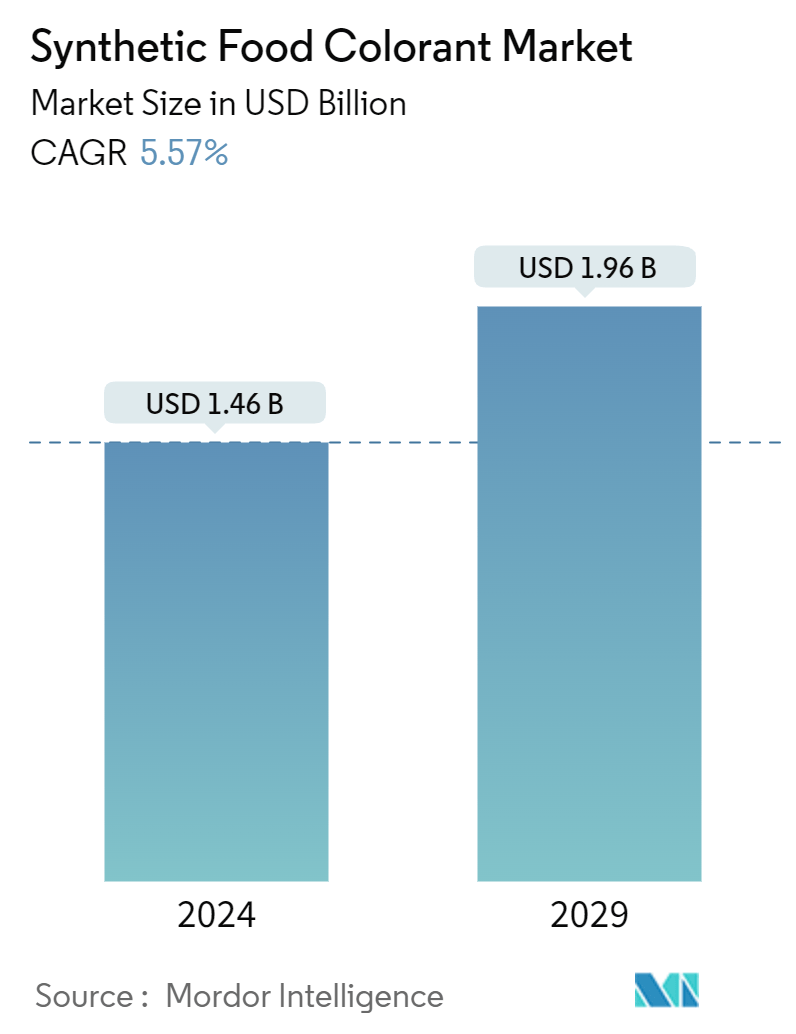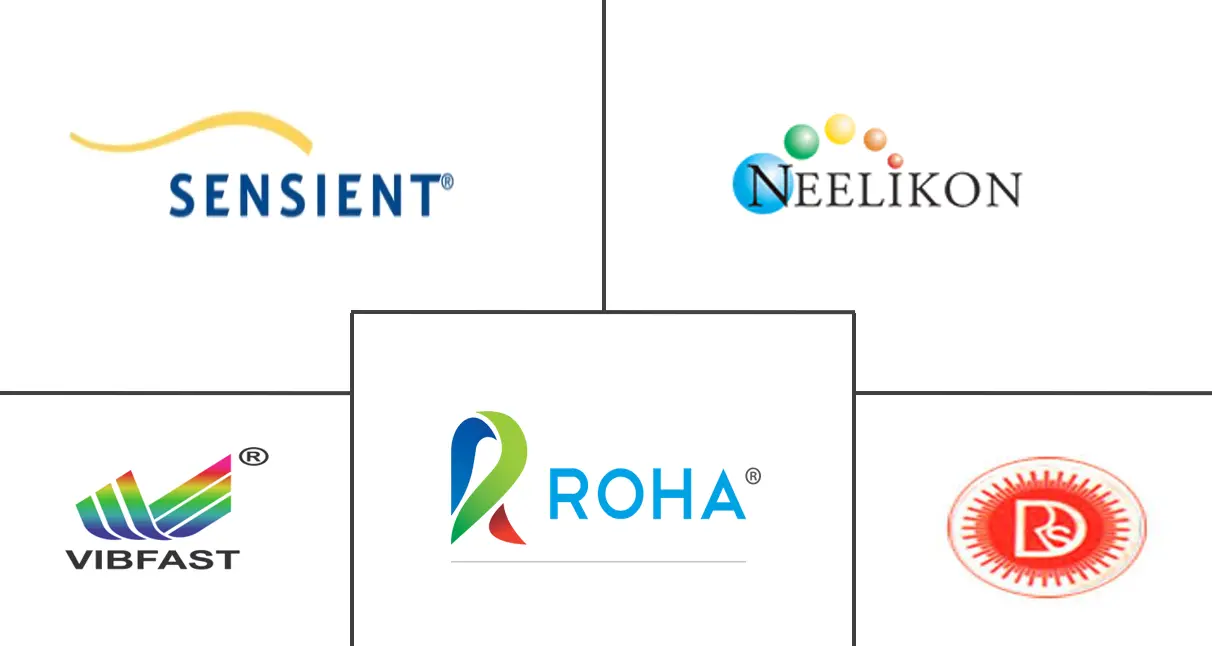Market Size of Synthetic Food Colorant Industry

| Study Period | 2019 - 2029 |
| Market Size (2024) | USD 1.46 Billion |
| Market Size (2029) | USD 1.96 Billion |
| CAGR (2024 - 2029) | 5.57 % |
| Fastest Growing Market | Asia Pacific |
| Largest Market | North America |
Major Players
*Disclaimer: Major Players sorted in no particular order |
Synthetic Food Colorant Market Analysis
The Synthetic Food Colorant Market size is estimated at USD 1.46 billion in 2024, and is expected to reach USD 1.96 billion by 2029, growing at a CAGR of 5.57% during the forecast period (2024-2029).
Synthetic food color plays a vital role in the appeal of food and beverage products, contributing to their visual allure and consumer acceptance. One of the primary aspects of using synthetic food colorants in food and beverages is to enhance the aesthetic appeal of food products. The synthetic food colorant market witnessed notable growth due to low cost, improved appearance, high color intensity, and more color stability and uniformity. The shift from synthetic colors to natural colors is anticipated to decelerate due to the higher cost of natural colorants. These properties of synthetic food colorants keep the upper edge compared to natural food colorants. The increased demand for processed food further enhances the demand for synthetic food colors. According to the Food and Health Survey of the International Food Information Council (IFIC), around 72% of Americans snacked at least once daily in addition to their main meals in 2022. The high demand for snacks, including bakery and other savory products, drives the market growth of synthetic food colorants.
The increasing demand among customers for diverse and vibrant colors inspired by different cultures and flowers is a key factor that could contribute to the expansion of extractive and colorful processed food. Younger consumers are eager to explore novel food and beverages, increasing the need for innovative products. Synthetic colorants are generally more stable than natural equivalents, resulting in lower usage levels to meet shelf-life objectives. Overall, the combination of lower usage rates and lesser production costs results in cost-in-use comparisons that are frequently several times lower than comparable natural color solutions. Therefore, the lower usage rates are the primary reason synthetic colors cost less than their synthetic counterparts. For instance, according to one of the leading synthetic food colorant manufacturers, Sensient Technologies, synthetic pure dyes contain over 90% pigment in their raw material. This, in turn, supports the market demand.
Synthetic Food Colorant Industry Segmentation
A chemical molecule created by artificial means to add color to food and beverages is known as a synthetic food colorant. These colorants are made in laboratories using chemical synthesis, not natural sources.
The synthetic food colorant market is segmented by color type, application, and geography. Based on color type, the market is segmented into blue, red, green, yellow, and other color type. Based on application, the market is segmented into beverages, dairy products, bakery and confectionery, snacks and cereals, and other applications. The beverages segment is further divided into carbonated soft drinks, juice and juice concentrates, functional beverages, alcoholic beverages, and other beverages. Based on geography, the market is segmented into North America, Europe, Asia-Pacific, South America, and the Middle East and Africa. The report offers the market size in value terms in USD for all the abovementioned segments.
| Color Type | |
| Blue | |
| Red | |
| Green | |
| Yellow | |
| Other Color Types |
| Application | |||||||
| |||||||
| Dairy Products | |||||||
| Bakery and Confectionery | |||||||
| Snacks and Cereals | |||||||
| Other Application |
| Geography | |||||||||
| |||||||||
| |||||||||
| |||||||||
| |||||||||
|
Synthetic Food Colorant Market Size Summary
The synthetic food colorant market is poised for significant growth, driven by the increasing demand for visually appealing food and beverage products. Synthetic colorants are favored for their cost-effectiveness, high color intensity, and stability, making them a preferred choice over natural alternatives despite the rising interest in natural colorants. The market's expansion is further fueled by the growing consumption of processed foods and snacks, where synthetic colorants enhance the visual appeal and consumer acceptance. The demand for vibrant and diverse colors, particularly among younger consumers, is also contributing to the market's growth, as these consumers seek novel and culturally inspired food experiences. The beverage industry, with its need for consistent and vibrant coloring, is a major contributor to the market's expansion, particularly in carbonated and ready-to-drink products.
North America holds a significant share of the synthetic food colorant market, supported by a robust food and beverage industry and regulatory approvals for synthetic colorants. The region's preference for processed and convenience foods drives the demand for synthetic colorants, which are extensively used to enhance the visual appeal of these products. The market is characterized by intense competition, with major players like Sensient Technologies Corporation and Vibfast Pigments Pvt. Ltd. expanding their production capabilities and product offerings to meet the growing demand. The strategic expansion of facilities and innovation centers by key players underscores the market's dynamic nature and the ongoing efforts to cater to the evolving needs of food manufacturers globally.
Synthetic Food Colorant Market Size - Table of Contents
-
1. MARKET DYNAMICS
-
1.1 Market Drivers
-
1.1.1 Booming Processed Food Industry Across the Globe
-
1.1.2 Low Processing Costs Coupled with High Extraction Yield
-
-
1.2 Market Restraints
-
1.2.1 Negative Health Impacts, Hampering the Market Growth
-
-
1.3 Porter's Five Forces Analysis
-
1.3.1 Threat of New Entrants
-
1.3.2 Bargaining Power of Buyers/Consumers
-
1.3.3 Bargaining Power of Suppliers
-
1.3.4 Threat of Substitute Products
-
1.3.5 Intensity of Competitive Rivalry
-
-
-
2. MARKET SEGMENTATION
-
2.1 Color Type
-
2.1.1 Blue
-
2.1.2 Red
-
2.1.3 Green
-
2.1.4 Yellow
-
2.1.5 Other Color Types
-
-
2.2 Application
-
2.2.1 Beverages
-
2.2.1.1 Carbonated Soft Drinks
-
2.2.1.2 Juice and Juice Concentrates
-
2.2.1.3 Functional Beverages
-
2.2.1.4 Alcoholic Beverages
-
2.2.1.5 Other Beverages
-
-
2.2.2 Dairy Products
-
2.2.3 Bakery and Confectionery
-
2.2.4 Snacks and Cereals
-
2.2.5 Other Application
-
-
2.3 Geography
-
2.3.1 North America
-
2.3.1.1 United States
-
2.3.1.2 Canada
-
2.3.1.3 Mexico
-
2.3.1.4 Rest of North America
-
-
2.3.2 Europe
-
2.3.2.1 Spain
-
2.3.2.2 United Kingdom
-
2.3.2.3 Germany
-
2.3.2.4 France
-
2.3.2.5 Italy
-
2.3.2.6 Russia
-
2.3.2.7 Rest of Europe
-
-
2.3.3 Asia-Pacific
-
2.3.3.1 China
-
2.3.3.2 Japan
-
2.3.3.3 India
-
2.3.3.4 Australia
-
2.3.3.5 Rest of Asia-Pacific
-
-
2.3.4 South America
-
2.3.4.1 Brazil
-
2.3.4.2 Argentina
-
2.3.4.3 Rest of South America
-
-
2.3.5 Middle-East and Africa
-
2.3.5.1 South Africa
-
2.3.5.2 Saudi Arabia
-
2.3.5.3 Rest of Middle-East and Africa
-
-
-
Synthetic Food Colorant Market Size FAQs
How big is the Synthetic Food Colorant Market?
The Synthetic Food Colorant Market size is expected to reach USD 1.46 billion in 2024 and grow at a CAGR of 5.57% to reach USD 1.96 billion by 2029.
What is the current Synthetic Food Colorant Market size?
In 2024, the Synthetic Food Colorant Market size is expected to reach USD 1.46 billion.

